Sambucus nigra
Sambucus nigra is a species complex of flowering plants in the family Adoxaceae native to most of Europe and North America.[1] Common names include elder, elderberry, black elder, European elder, European elderberry, and European black elderberry.[2][3] It grows in a variety of conditions including both wet and dry fertile soils, primarily in sunny locations. Elder is cited as a poisonous plant for mammals, and as a weed in certain habitats.[4] The plant is a very common feature of hedgerows and scrubland in Britain and northern Europe, but is also widely grown as an ornamental shrub or small tree. Both the flowers and the berries have a long tradition of culinary use, primarily for cordial and wine.[5] The Latin specific epithet nigra means "black", and refers to the deeply dark colour of the berries.[6]
| Sambucus nigra | |
|---|---|
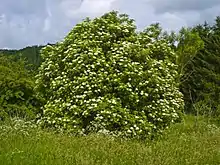 | |
| Shrub in flower | |
| Scientific classification | |
| Kingdom: | Plantae |
| Clade: | Tracheophytes |
| Clade: | Angiosperms |
| Clade: | Eudicots |
| Clade: | Asterids |
| Order: | Dipsacales |
| Family: | Adoxaceae |
| Genus: | Sambucus |
| Species: | S. nigra |
| Binomial name | |
| Sambucus nigra | |
Although elderberry is commonly used in dietary supplements and traditional medicine, there is no scientific evidence that it provides any benefit for maintaining health or treating diseases.[7]
Description
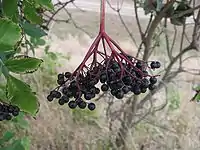
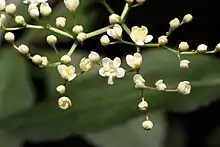
Elderberry is a deciduous shrub or small tree growing to 6 m (20 ft) tall and wide,[5] rarely reaching 10 m (33 ft) tall. The bark, light grey when young, changes to a coarse grey outer bark with lengthwise furrowing, lenticels prominent.[8] The leaves are arranged in opposite pairs, 10–30 cm long, pinnate with five to seven (rarely nine) leaflets, the leaflets 5–12 cm long and 3–5 cm broad, with a serrated margin. The young stems are hollow.[9] The English term for the tree is not believed to come from the word "old", but from the Anglo Saxon æld, meaning fire, because the hollow stems of the branches were used as bellows to blow air into a fire.[10]
The hermaphroditic flowers have five stamens,[11] which are borne in large, flat corymbs 10–25 cm diameter in late spring to mid-summer, the individual flowers are ivory white, 5–6 mm diameter, with five petals; they are pollinated by flies.
The fruit is a glossy, dark purple to black berry 3–5 mm diameter, produced in drooping clusters in late autumn;[5] they are an important food for many fruit-eating birds, notably blackcaps.
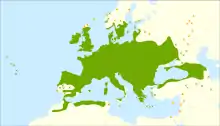

Subspecies
There are several other closely related species, native to Asia and North America, which are similar, and sometimes treated as subspecies of Sambucus nigra. The blue or Mexican elderberry, Sambucus mexicana, is now generally treated as one or two subspecies of Sambucus nigra subsp. canadensis[12] and Sambucus nigra subsp. caerulea.[13]
Habitat
Hedges, waste-ground roadsides, and woods are the typical habitats for the species.[11] S. nigra is recorded as very common in Ireland in hedges as scrub in woods.[14][15]
Cultivation
Some selections and cultivars have variegated or coloured leaves and other distinctive qualities, and are grown as ornamental plants.
The following cultivars have gained the Royal Horticultural Society's Award of Garden Merit:[16]
Culinary uses

The dark blue or purple berries are mildly poisonous in their raw state.[20] Unripe berries, the seeds of the fruit, and all green parts of the plant are poisonous, containing cyanogenic glycosides (Vedel & Lange 1960). The berries are edible after cooking and may be used to make jam, jelly,[21] chutney, and Pontack sauce. In Scandinavia and Germany, soup made from the elderberry (e.g. the German Fliederbeersuppe) is a traditional meal.
Commonly, the flowerheads are used in infusions, giving a drink in Northern Europe and the Balkans. These drinks are sold commercially as elderflower cordial.[22] In Europe, the flowers are made into a syrup or cordial (in Romanian: Socată, in Swedish: fläder(blom)saft, in Danish: hyldeblomstsaft / hyldedrik), which is diluted with water before drinking. The popularity of this traditional drink recently has encouraged some commercial soft drink producers to introduce elderflower-flavoured drinks (Fanta Shokata, Freaky Fläder). The flowers also may be dipped into a light batter and then fried to make elderflower fritters.
The berries may be made into elderberry wine.[21] In Hungary, an elderberry brandy is made that requires 50 kg of fruit to produce 1 litre of brandy. In south-western Sweden, it is traditional to make a snaps liqueur flavoured with elderflower. Elderflowers are used in liqueurs such as St-Germain, and in a mildly alcoholic sparkling elderflower 'champagne', although a more alcoholic home-made version can be made. In Beerse, Belgium, a variety of jenever called beers vlierke is made from the berries.
Traditional medicine


This plant is used in traditional medicine by native peoples and herbalists.[7][23] Extracts of the flowers and fruits are used for cold and flu symptoms,[7][24] although there is no high-quality clinical evidence that it is effective for treating any disease.[7]
Potential for poisoning
Consumption of raw elderberries, leaves, bark, and stems, if not properly prepared, may cause nausea, vomiting, and severe diarrhea through the toxic effects of cyanogenic glycosides.[7][25] Elderberry plant constituents or products should not be consumed during pregnancy or by people with allergies or gastrointestinal diseases.[25] Elderberry products may cause adverse effects when used with prescription drugs.[25]
Diseases
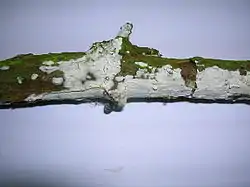
Like other elderberries, Sambucus nigra is subject to elder whitewash fungus and jelly ear fungus.
Wildlife value
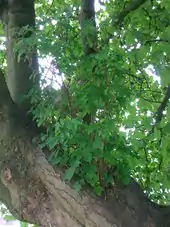
Elder rates as fair to good forage for animals such as mule deer, elk, sheep, and small birds. It is classified as nesting habitat for many birds, including hummingbirds, warblers, and vireos. Ripe elderberries are a favorite food for migrating band-tailed pigeons in northern California, which may sometimes strip an entire bush in a short time. It is also a larval host to the spring azure.[26] It is good habitat for large and small mammals.[27]
Poisonous to mammals
Except for the flowers and ripe berries (but including the ripe seeds), all parts of the plant are poisonous to mammals, containing the cyanogenic glycoside sambunigrin (C14H17NO6, CAS number 99-19-4).[28] The bark contains calcium oxalate crystals.
Other uses
The strong-smelling foliage was used in the past, tied to a horse's mane, to keep flies away while riding.
References
- "Flora Europaea Search Results". Rbg-web2.rbge.org.uk. Retrieved 13 October 2017.
- "Sambucus nigra". Integrated Taxonomic Information System.
- "Plants Profile for Sambucus nigra (black elderberry)". Plants.usda.gov. Retrieved 13 October 2017.
- "Sambucus nigra". Germplasm Resources Information Network (GRIN). Agricultural Research Service (ARS), United States Department of Agriculture (USDA). Retrieved 12 December 2017.
- RHS A-Z encyclopedia of garden plants. United Michael and Vikram: Dorling Kindersley. 2008. ISBN 978-1405332965.
- Harrison, Lorraine (2012). RHS Latin for Gardeners. United Kingdom: Mitchell Beazley. ISBN 978-1845337315.
- "European elder". National Center for Complementary and Integrative Health, US National Library of Medicine. 1 September 2016. Retrieved 10 July 2020.
- Clapham, A.R., Tutin, T.G. and Warburg, E.F. 1968 Excursion Flora of the British Isles Second Edition Cambridge.ISBN 0-521-04656-4
- Vedel, H. and Lange, J. 1971. Trees and Bushes in Wood and Hedgerow. p.196. Methuen and Co. Ltd. ISBN 0416-61780-8
- "Elder (Sambucus nigra) - British trees -". Woodland Trust. Retrieved 3 November 2017.
- Parnell, J. and Curtis, T. 2012. Webb's An Irish Flora. Cork University Press. ISBN 978-185918-4783
- "Sambucus mexicana". Calflora. Retrieved 2012-07-16.
- "Sambucus nigra ssp. caerulea". Calflora. Retrieved 2012-07-16.
- Hackney, P. 1992. Stewarts and Corry's Flora of the North-east of Ireland. Institute of Irish Studies The Queen's University of Belfast. ISBN 0 85389 446 9(HB)
- Webb, D.A., Parnell, J. and Doogue, D. 1996. An Irish Flora. Dundalgan Press Ltd, Dundalk. ISBN 0-85221-131-7
- "AGM Plants - Ornamental" (PDF). Royal Horticultural Society. July 2017. p. 95. Retrieved 21 October 2018.
- "RHS Plantfinder - Sambucus nigra 'Eva'". Retrieved 21 October 2018.
- "RHS Plant Selector Sambucus nigra f. laciniata AGM / RHS Gardening". Apps.rhs.org.uk. Retrieved 2012-07-16.
- "RHS Plant Selector Sambucus nigra f. porphyrophylla 'Gerda' PBR AGM / RHS Gardening". Apps.rhs.org.uk. Retrieved 2012-07-16.
- Professor Julia Morton, University of Miami
- Fagan, Damian (2019). Wildflowers of Oregon: A Field Guide to Over 400 Wildflowers, Trees, and Shrubs of the Coast, Cascades, and High Desert. Guilford, CT: FalconGuides. p. 16. ISBN 978-1-4930-3633-2. OCLC 1073035766.
- Kikbracken, J. 1995. Easy way guide Trees. Larousse.
- "Sambucus nigra Elderberry - European Elder, Black elderberry, American black elderberry, Blue elderberry, Europea PFAF Plant Database". Pfaf.org. Retrieved 13 October 2017.
- Christophe Wiart (2006), Medicinal Plants of the Asia-Pacific: Drugs for the Future?, World Scientific, ISBN 981-256-341-5
- "Elderberry". Memorial Sloan Kettering Cancer Center. 2020. Retrieved 11 July 2020.
- The Xerces Society (2016), Gardening for Butterflies: How You Can Attract and Protect Beautiful, Beneficial Insects, Timber Press.
- "Sambucus nigra subsp. cerulea". Fs.fed.us. Retrieved 13 October 2017.
- Campa C, Schmitt-Kopplin P, Cataldi TR, Bufo SA, Freitag D, Kettrup A (2000). "Analysis of cyanogenic glycosides by micellar capillary electrophoresis". Journal of Chromatography B. 739 (1): 95–100. doi:10.1016/S0378-4347(99)00375-8. PMID 10744317.
Further reading
- Blanchan, Neltje (1900). Wild Flowers: An Aid to Knowledge of our Wild Flowers and their Insect Visitors. New York City: Doubleday. OCLC 16950204.
- Rushforth, K. (1999). Trees of Britain and Europe. HarperCollins ISBN 0-00-220013-9.
External links
![]() Media related to Sambucus nigra at Wikimedia Commons
Media related to Sambucus nigra at Wikimedia Commons